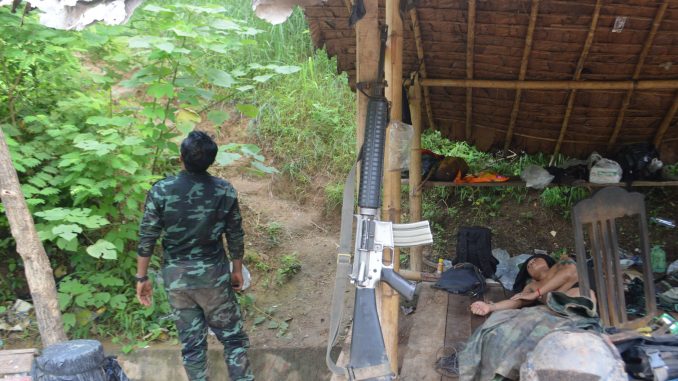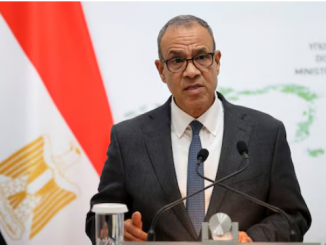
Jets Overhead, Watching for Airstrike. Photo by Antonio Graceffo
| Published August 19, 2025
1. A Battlefield in Flux: Frontline Shifts and Strategic Tensions
Myanmar’s civil war continues to evolve, with resistance forces entrenching and expanding their control across the country:
-
Ethnic Armed Organizations (EAOs) such as the Arakan Army (AA), Kachin Independence Army (KIA), Ta’ang National Liberation Army (TNLA), and others have made major territorial gains, pushing the junta from rural areas and enabling resistance expansion into central Myanmar through “buffer zone” strategies.
-
The Battle of Falam (Nov 2024 – April 2025) ended in a sweeping rebel victory, with allied resistance groups capturing the town and ousting junta forces even amid heavy casualties.
-
Kyaukphyu remains fiercely contested. The Arakan Army’s offensive since February 2025 has displaced tens of thousands, while killing or injuring dozens.
-
In Kachin State, the Battle of Bhamo (Dec 2024 – 2025) saw initial KIA advances including capture of the airport and several military battalions, followed by junta counterattacks and heavy bombardments.
-
The Sagaing Region’s Katha Township saw a notable defeat of junta forces by the People’s Defence Force (PDF) in March 2025.
-
Nawnghkio, near the China border, fell back to junta control in a major blow to the TNLA and the Three Brotherhood Alliance, after nearly a year under resistance control.
2. Civilian Toll and Humanitarian Crisis
The human cost of the conflict is staggering:
-
Airstrikes and bombardments have repeatedly hit civilian targets, including hospitals and monasteries. A recent strike on Mogok killed at least 21 civilians, including women and a pregnant woman.
-
In Kayah State, a military bombing of a hospital killed at least 24 civilians—some reports suggest the toll may be higher.
-
The civilian toll so far exceeds 50,000 deaths and 3 million displaced residents.
-
Explosive remnants, particularly landmines, have inflicted horrifying casualties—over 250 children were reported injured or killed by late 2024.
3. Technology, Countermeasures, and Strategic Pressure
Advancements in warfare and shifting geopolitics are reshaping the battlefield:
-
Suicide drones (including FPV and thermal-equipped versions) have emerged as lethal force multipliers, including in the Bhamo theater where they downed junta helicopters—a first in the conflict.
-
China’s role remains significant: border control crackdowns, pressure on EAOs (like MNDAA/MNTJP), and military posturing suggest Beijing is leaning towards the junta—though resistance groups continue coordinating operations across regions.
4. Political Undercurrents and the Shadow of Elections
Despite active warfare, political maneuvers are underway:
-
Elections are scheduled for Dec 28, 2025, but control over much of the country is contested, with resistance fighters vowing massive disruption.
-
Junta leadership—especially Min Aung Hlaing—has ramped up security measures, introduced punitive election laws, and established civilian-appearing authorities to legitimize its power.
Summary Table: Key Battlefronts & Dynamics
| Front / Battle | Key Developments | Humanitarian Impact |
|---|---|---|
| Falam (Chin State) | Rebel capture of strategic town; high resistance casualties | Heavy civilian disruption |
| Kyaukphyu (Rakhine) | Arakan Army offensive; displacement + casualties | ~40,000 displaced; major collateral damage |
| Bhamo (Kachin) | KIA captured infrastructure; junta counterstrike | Urban combat, bombardments |
| Katha (Sagaing) | PDF repelled junta offensive | Local resistance success |
| Nawnghkio | Junta recaptured from TNLA | Displacement, loss of rebel-held supply routes |
| Civilians Nationwide | Airstrikes, landmines, displacement, hospital bombings | Mounting casualties and suffering |
| Geopolitics & Tech | Drone warfare, China’s shifting posture | New threats, border instability |
| Elections 2025 | Junta pushing ahead amid conflict | Political facade under violent backdrop |
Photo by Antonio Graceffo
Photo by Antonio Graceffo
Photo by Antonio Graceffo
Photo by Antonio Graceffo
 Implications of the War in Burma — At the Battle Front
Implications of the War in Burma — At the Battle Front
1. Humanitarian Catastrophe Intensifying
-
With over 3 million displaced and tens of thousands dead, the war is creating one of Asia’s worst humanitarian crises.
-
Continued airstrikes on civilian zones (monasteries, hospitals, IDP camps) show that the junta is willing to target non-combatants, raising the risk of international war crimes investigations.
-
Refugee flows into Thailand, India, and China could destabilize border regions and strain humanitarian resources.
2. Regional Stability Under Threat
-
The fighting near the China-Myanmar border (e.g., Nawnghkio, Muse) puts Beijing in a delicate position—balancing its investments in pipelines and trade corridors with concerns about instability spilling over.
-
Thailand and India are quietly fortifying border areas, fearing cross-border violence and refugee influx.
-
The conflict threatens the security of China’s Belt and Road projects and India’s Act East policy, making Myanmar a key fault line in regional geopolitics.
3. Geopolitical Chessboard
-
China has shown signs of tilting toward the junta by tightening border controls and pressuring ethnic groups, but Beijing also maintains back channels with ethnic armies to safeguard its influence.
-
Western nations (U.S., EU, Australia) continue sanctions but lack leverage—raising the possibility of proxy involvement via support to resistance forces.
-
Russia remains one of the junta’s top arms suppliers, further embedding Moscow’s influence in Southeast Asia.
4. Military Innovation and Escalation
-
The spread of suicide drones, FPVs, and improvised air defenses is reshaping battlefield dynamics.
-
Rebel groups have shown they can down junta aircraft, weakening air superiority and inspiring other insurgent groups globally.
-
This “low-cost drone warfare” could serve as a model for other asymmetric wars.
5. Political Legitimacy Crisis
-
The junta’s planned December 2025 elections are widely viewed as a façade to claim legitimacy while most of the country remains a warzone.
-
Resistance forces have pledged to disrupt elections, meaning violence is likely to intensify in the coming months.
-
International recognition of the junta remains weak, but a staged election could create a diplomatic dilemma for ASEAN, which struggles to balance non-interference with calls for peace.
6. Economic Fallout
-
Myanmar’s natural resources (jade, rubies, rare earths, oil & gas pipelines) are under threat.
-
Disruptions in Rakhine State (Kyaukphyu) threaten Chinese oil & gas terminals critical for Beijing’s energy security.
-
Sanctions and instability could deepen Myanmar’s isolation, forcing the junta to rely heavily on China and Russia—making it a client state economically.
Photo by Antonio Graceffo

Photo by Antonio Graceffo
The author, Antonio Graceffo, reporting from Burma via Starlink.
 Overall Takeaway:
Overall Takeaway:
The war in Burma is no longer confined to isolated clashes—it has become a nationwide struggle for survival and legitimacy. On the ground, resistance forces have demonstrated resilience and ingenuity, seizing territory, employing drone warfare, and building alliances across ethnic lines. At the same time, the junta continues to wield brutal air power and relies heavily on foreign backing to maintain control.
Yet, beyond the shifting frontlines, the human toll is devastating: millions displaced, tens of thousands killed, and entire towns reduced to rubble. The conflict has pushed Myanmar to the edge of state collapse, while dragging in regional powers whose economic and security interests are now directly at stake.
As the junta pushes ahead with its December 2025 elections in a fractured nation, the fighting shows no signs of abating. Instead, the coming months may bring greater escalation, with both sides seeking decisive victories before the vote. For the people of Burma, the battlefield is not just a contest of arms but a fight for freedom, identity, and the hope of a future beyond tyranny.
The outcome of this war will determine not only the fate of Myanmar’s democracy but also the strategic balance of power in Southeast Asia—a conflict whose reverberations may be felt far beyond its borders.
SOURCES: THE GATEWAY PUNDIT – The War in Burma — At The Battle Front
AP NEWS – Myanmar military recaptures strategic town from rebels after a year, government says
ASIA TIMES – Siege warfare keeping Myanmar military in the fight
THE TIMES – In a war to oust Myanmar’s junta, the earthquake barely registers











Be the first to comment